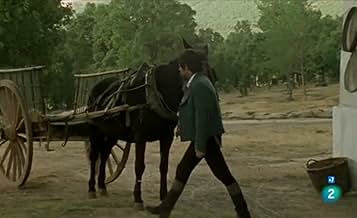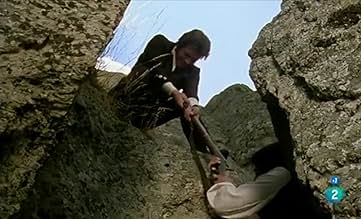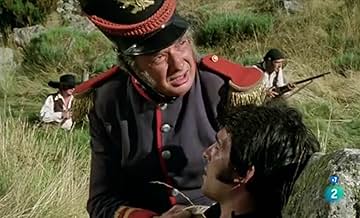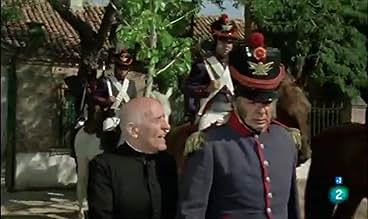Set in 19th-century Southern Spain, this successful TV series features the endless adventures of Curro Jiménez (prototype of the Andalusian "bandolero"), a kind of Spanish Robin Hood, and hi... Read allSet in 19th-century Southern Spain, this successful TV series features the endless adventures of Curro Jiménez (prototype of the Andalusian "bandolero"), a kind of Spanish Robin Hood, and his gang, the two main members of which are El Estudiante and El Algarrobo. The plot changes... Read allSet in 19th-century Southern Spain, this successful TV series features the endless adventures of Curro Jiménez (prototype of the Andalusian "bandolero"), a kind of Spanish Robin Hood, and his gang, the two main members of which are El Estudiante and El Algarrobo. The plot changes in every episode, but all have the theme of the legendary bandit--fair, brave, and good-n... Read all
- Awards
- 3 wins & 2 nominations total
Featured reviews
This excellent TV series run in Televisión Española (the Spanish national public network) for three seasons (1976-79).
Its main character was loosely based in real-life bandolero Francisco "Curro" Jiménez Ledesma, from whom it barely took his name and little else, as most of the characters and events depicted were made up by the screenwriters and even the historic period was not consistent with that of the real Curro.
Curro Jiménez's gang lived a different adventure each episode, even though some of them took two, and the pilot was longer (and sometimes confused with the spin-off film), such a band was composed of Curro (Sancho Gracia) and his partners: el Estudiante ("the Student" Pepe Sancho), el Algarrobo (Álvaro de Luna) and el Fraile ("the Monk"), the latter was substituted by a new one, el Gitano ("the Gypsy" Eduardo García), when the actor who played it, Paco Algora left the show seeking (unsuccessfully) a better acting career playing main roles in cinema.
Being shot during the political transition between a military dictatorship and a democracy in Spain, the series was set in the 19th century, thus Curro and his men's struggle against the French invaders during the Spanish Independence War, and afterwards against the rural feuds, mirrored the struggle of the Spanish people themselves.
All the technical and artistic features: cinematography, music (unforgettable tune), acting etc were impeccable.
In its time the series made famous the actors who played its protagonists, as it was very popular in Spain and all over South America, giving birth to a couple of spin-offs.
In all, I guess to an American audience it must look like a mixture between El Zorro, "For a Fistful of Dollars", "the Magnificent Seven" and "The Wild Bunch", with a 19th century Southern Spanish setting.
In my opinion it was a great, funny, enjoyable, entertaining and action-packed show, I hope you will enjoy Curro's adventures, robbing stagecoaches, assaulting French military headquarters and being pursued by ruthless lawmen, as much as I did in my childhood.
If you already watched it and enjoyed it do not miss the above mentioned "Amanecer en Puerta Oscura" and "Llanto por un Bandido" and, of course, "Avisa a Curro Jiménez" (also known as "Curro Jiménez, the Movie"), and avoid at all costs its awful 1990s sequel "Curro Jiménez II: El Regreso de una Leyenda".
Successful and immortal TV series usually exhibited in TVE (Spanish television) . Interesting and moving plots in which the screenplays changed in every episode , having in common the theme of the legendary bandit . In the series there are fights , love stories , noisy action , go riding , Flamenco music , emotion and even some comedic episodes . The stunning series got a hit smash , as Spain as Latino America , giving birth to a couple of spin-offs , such as ¨La Mascara Negra¨ or ¨Black Mask¨, also starred by Sancho Gracia . The starring was loosely based on a real-life character, the 19th century bandit Francisco "Curro" López Jiménez . They mainly borrowed his nickname and little else , as most of the facts and characters were made up by the screenwriters , and even the historic period is not consistent with that of the real Curro Jiménez . Very good acting by Sancho Gracia as the tough , two-fisted Curro Jimenez , prototype of the Andalusian "bandolero" , a kind of Spanish Robin Hood who struggles against the French invaders during the Spanish Independence War . Sancho Gracia/Curro carries out his usual stoic acting and displays efficiently his weapons , such as ¨blunderbuss¨ , and killing mercilessly villains . Curro is a fair , brave and good-natured person who delivers peace and justice , using force and taking the law into his own revengeful hands and acting as judge , jury and executioner . It's certainly thrilling , though the morality may be questionable , even in this time , as the spectators were clearly on the Curro Jimenez's side , in spite of his expeditious and violent executions . Special mention for Alvaro De Luna who steals the show as the brute , illiterate and naive Algarrobo . Support cast is frankly excellent , here appears the ordinary actors from Paella Western such as Frank Braña , Aldo Sambrell , Chris Huerta , Tito Garcia , Jose Canalejas , Lorenzo Robledo , Rafael Albaicín , Roberto Camardiel , Daniel Martin , Conrado San Martin , Antonio Molino Rojo , Charly Bravo , Diana Lorys , and several others . Evocative musical score , including catching leitmotiv by guitar , composed by Waldo Rios who subsequently committed suicide himself . Adding Flamenco score , Andalucian songs and typical dances . Nice and atmospheric cinematography by Francisco Fraile and Hans Burmann . And splendid set and production design by Wolfgang Burmann , Luis Argüello , Fernando Sáenz , shot on location in Andalucia and especially Ronda, Malaga , Despeñaperros and Almeria .
It is formed by 40 episodes , shooting of the first season of the series took place in 1975, its first episode aired on TVE1 on 22nd December 1976 . Being ordinary show-runner , the prestigious Antonio Larreta who wrote thrilling scripts and compellingly directed by the best filmmakers of the Spanish cinema , such as : Joaquín Luis Romero Marchent (12 episodes, 1976-1978) , his brother Rafael Romero Marchent (3 episodes, 1977) , both of whom experts on Paella/Chorizo/Pasta Western . And Mario Camus (10 episodes, 1977-1979) , Pilar Miró (5 episodes, 1977-1978) , Fernando Merino (4 episodes, 1977-1978) , Antonio Drove (3 episodes, 1977) and Francisco Rovira Beleta (3 episodes, 1977)
Did you know
- TriviaThe protagonist was loosely based on a real-life character, the 19th century bandit Francisco "Curro" López Jiménez. They mainly borrowed his nickname and little else, as most of the events and characters were made up by the screenwriters, and even the historic period is not consistent with that of the real Curro Jiménez.
- ConnectionsFeatured in Spanish Western (2014)
- How many seasons does Curro Jiménez have?Powered by Alexa
Details
Contribute to this page























